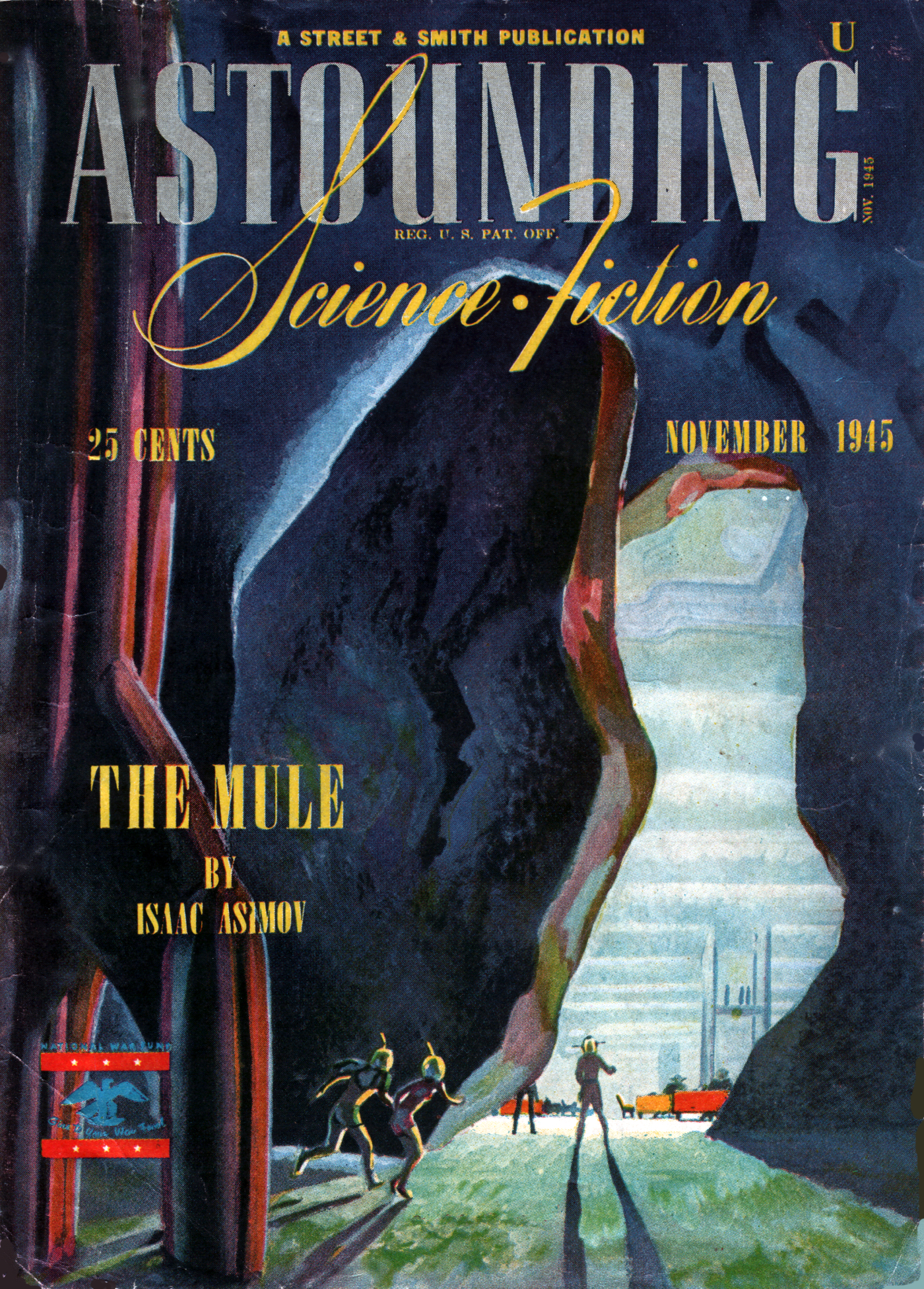The Mule
by Isaac Asimov
Astounding Science Fiction
November & December 1945
part of the Foundation series;
it comprises the second half of —
Foundation and Empire;
which is the middle book of —
Psychohistory rebuilds the Empire
Isaac Asimov's Foundation series appeared in Astounding Science Fiction intermittently from 1942 through 1950, and for long years has been a favorite of fans. It describes a multi-century vision, worked out with Astounding's editor John W. Campbell, of a Galactic Empire in decline and fall, followed by a chaotic Interregnum which may lead eventually to a new and better Empire. The statistical / sociological science of Psychohistory is the means by which the chaos and wars may be shortened by many millennia. Psychohistory is a predictive science, Hari Seldon's master plan for humanity, giving useful information only at the heights of mathematical abstraction over major populations. Eventually, after the Interregnum, all will march into the socio-mathematically managed Utopia.
The Foundation stories are dry and talky, very thin of action taking place onstage. Asimov's own acknowledgement of this was clear when he was prevailed upon, many years later, to write additional Foundation novels and he wanted to write to a similar plain style; and in fact those latter books are not only as dry but virtually action-free.
"The Mule" is different. This novella is Asimov's own favorite of the original stories, and deservedly so. Its striking title character is Asimov's most memorable ever, and is vividly and sensitively portrayed. The Mule, as he calls himself, is a human mutant: a telepath and telempath able to share and manage both thoughts and emotions.
The Mule is effectively a superman, and he stands out the more because the billions of people in the galaxy are statistical sheep, units in the vast sweep of Psychohistorical analysis. This makes plotting the Foundation series rather challenging; if your side is going to win or lose each conflict as predicted by Psychohistory, then why worry about intelligence, initiative, or bravery? Psychohistory depends upon the sheep staying unaware of their secret sociomath-kings (my coinage here). Once the citizens see the inexorable predetermination of their history, why bother to continue? In fact, once the readers of Astounding see the inexorable pattern of the Foundation series, why keep reading? — Hence, "The Mule".
This anticipatory effect also may have discouraged publication in three hardcover volumes. Major publishers Doubleday and Little, Brown both rejected the Foundation series for hardcover publication in 1950, leaving it to the small genre publisher Gnome Press. Ace Books' 1950s paperback editions were subject to their abridging and retitling. A smarter Doubleday editor, Timothy Seldes, picked up the series in 1961 for unabridged hardcovers.
The original Foundation stories from the 1940s comprising The Foundation Trilogy perhaps illustrate Asimov's maturation during his twenties. The earlier section (1942-1945) of The Foundation Trilogy feels much more old-fashioned: dry interstellar geopolitical chronicles of the Foundation. The latter section (1948-1950) includes many more fictional values: romances, landscapes, and interesting people; but the plot has simplified to a mystery, a search. In fact, the same mystery-search is repeated from different angles.
"The Mule" (1945) is at the hinge of these two types, has a few weaknesses of both but many more strengths. It was Asimov's first magazine serial (two installments), and embodies about a fifth of the word-length of The Foundation Trilogy, heroically lifting the series out of the Psychohistorical doldrums in the course of presenting the greatest challenge both to the Foundation and to Psychohistory. A distinctive story, and if I were to recommend a handful of Isaac Asimov's best fictions of any length, I'd include "The Mule".
Fortunately, geopolitical chronicles of Psychohistory do not define "The Mule". For sheer storytelling, "The Mule" is the centerpiece of the Foundation series: the arrival of the Mule is like a skyrocket among the statistical sheep. And Asimov's sensuous description of the Visi-Sonor, a sort of musical instrument upon which one plays and displays emotional colors and music, is wonderfully evocative. If that great science-fictional sensualist Theodore Sturgeon had invented an instrument to represent what science-fiction done right feels like to its own best practitioners — even to the plain-speaking Asimov — Sturgeon might have described a Visi-Sonor as Asimov has here. It is a pioneering science-fictional highlight not to be missed.
© 2006 Robert Wilfred Franson
Psychohistorical Crisis
by Donald Kingsbury
Demigoddess of the Mind:
James H. Schmitz's heroine Telzey Amberdon
Science at Troynovant
history, prospects, scientific method
Utopia at Troynovant
utopia in power, or dystopia
magazine cover, bottom:
Astounding Science Fiction
November 1945
by William Timmins
Mentality at Troynovant
the mind & mental operation
Music at Troynovant
music, song, dance, & composers

| Troynovant, or Renewing Troy: | New | Contents | |||
| recurrent inspiration | Recent Updates | |||
|
www.Troynovant.com |
||||
|
Reviews |
||||
| Personae | Strata | Topography |
|
|||